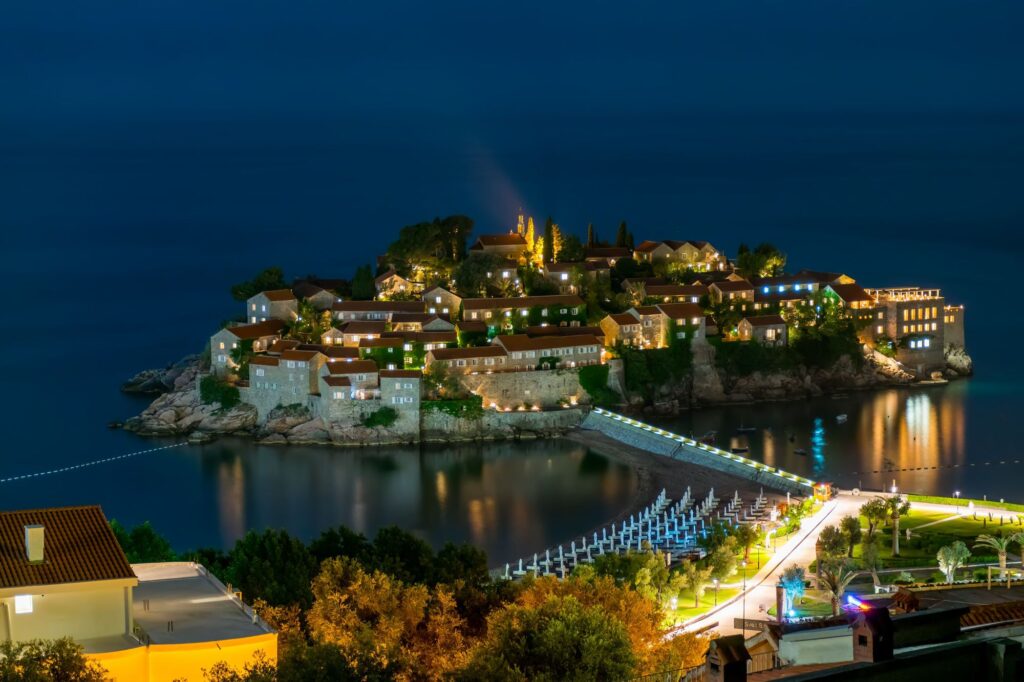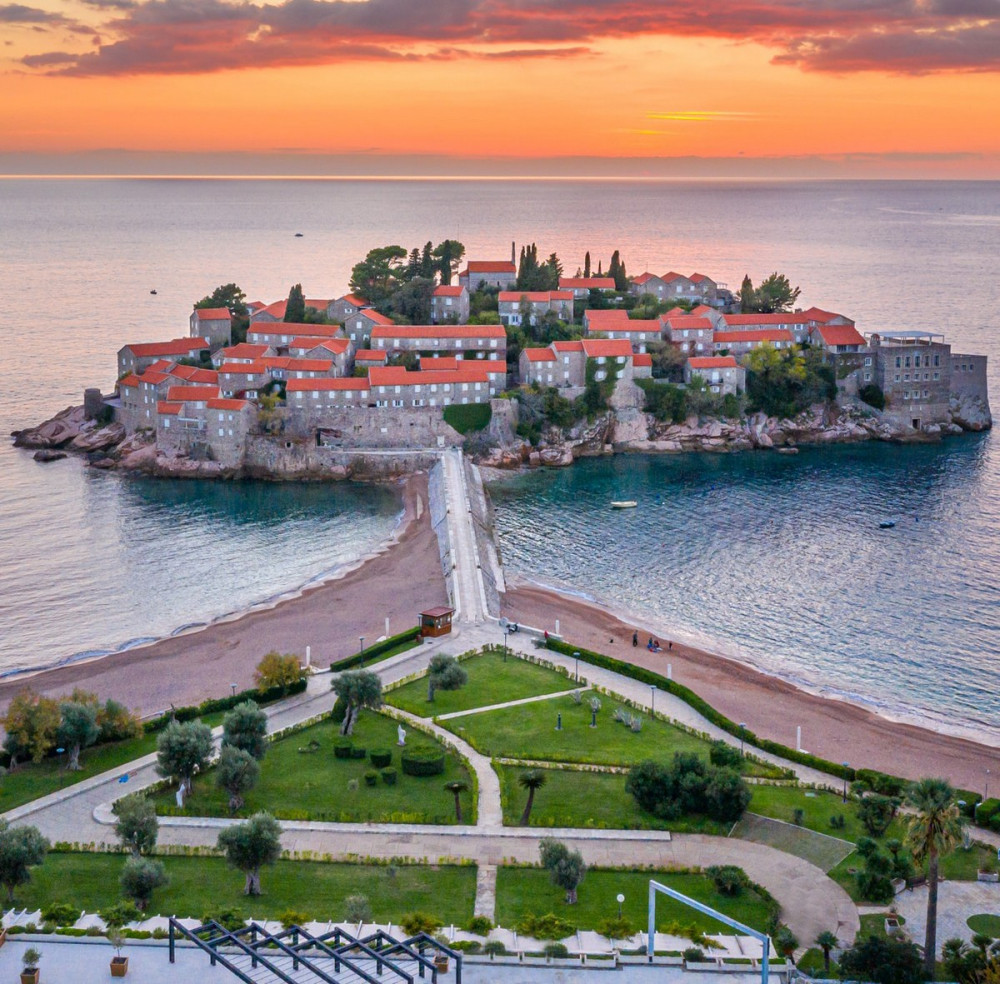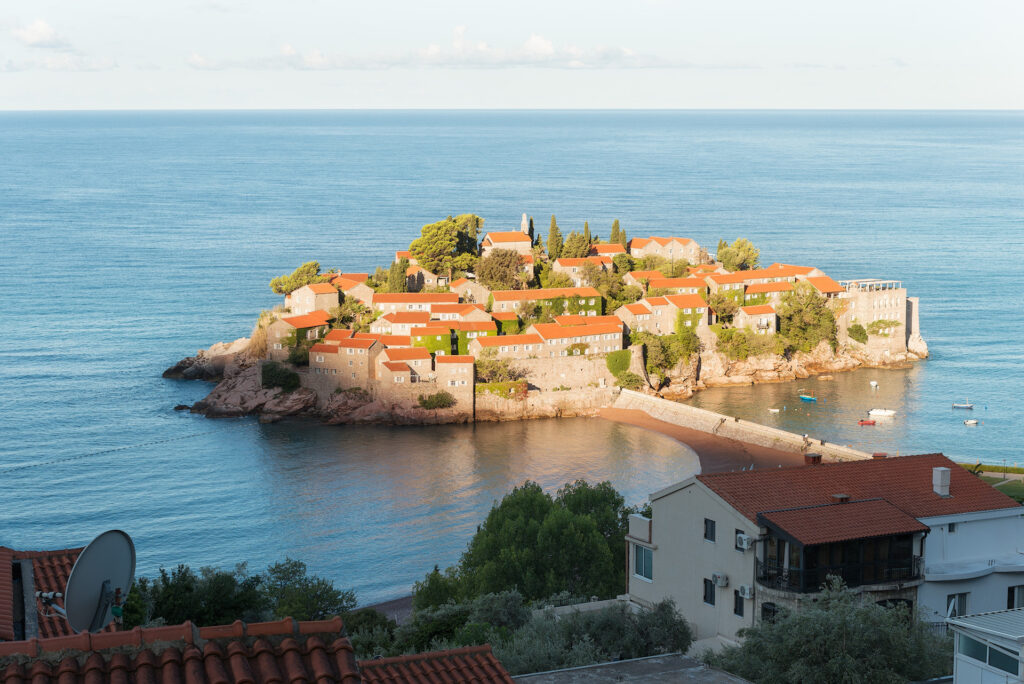History of Sveti Stefan island
Nestled on the Adriatic coast of Montenegro, Sveti Stefan Island stands as an emblem of the nation’s rich past and architectural splendor. A causeway connecting the mainland to this petite isle offers not only a pathway for tourists but also a bridge to the bygone times.
Centuries ago, the island was a simple fishermen’s village. However, with the ebb and flow of time, it transformed. By the 15th century, the island, fortified against invaders, became a refuge for the locals during Ottoman incursions. Numerous tales of valiant defenses and community unity are still whispered amongst the old stone buildings.
In the mid-20th century, the island underwent another significant metamorphosis. The government of then-Yugoslavia, recognizing the touristic potential of history of Sveti Stefan island, embarked on an ambitious project to convert the island into a luxury resort. The revamped Sveti Stefan Island attracted the global elite, including Hollywood stars and renowned writers.
Today, the history of Sveti Stefan island transcends beyond its luxury resorts and panoramic vistas. It stands as a testament to Montenegro’s resilience, its adaptability, and its undying allure. Every stone on the island, every wave that crashes against its shores, echoes the tales of a dynamic history that has shaped the cultural fabric of the nation. The importance of Sveti Stefan Island, both historically and in the contemporary era, can’t be overstated. It’s not just a retreat for the weary traveler but a portal into Montenegro’s storied past.

Geography of Sveti Stefan Island
The allure of Montenegro’s coast is beautifully encapsulated in Sveti Stefan Island, a picturesque gem floating in the azure Adriatic waters. This island’s unique geographical setting contributes to its distinctive landscape and microclimate, making it a coveted destination for nature enthusiasts and relaxation seekers alike.
Geographically, Sveti Stefan Island is a small, rocky outcrop, connected to the mainland by a narrow isthmus. This connection has allowed both the terrestrial and marine ecosystems to flourish, creating a harmonious blend of land and sea. Olive trees, pines, and cypress groves cloak the island, their roots delving deep into the rocky terrain, giving it a verdant appearance amidst the blue canvas of the Adriatic.
One of the remarkable aspects of Sveti Stefan Island is its microclimate. Positioned off the Montenegrin coast and buffered by the sea on all sides, the island enjoys a Mediterranean climate characterized by warm summers and mild winters. The surrounding waters play a crucial role in modulating temperatures, ensuring that extremes are rare. This maritime influence brings in gentle breezes, ensuring the air remains fresh and invigorating.
Furthermore, the island’s topography, with its terraced landscapes and sloping terrain, creates multiple viewpoints from which one can witness the sun’s dance on the water at both dawn and dusk. Each viewpoint offers a new perspective, a fresh shade of nature’s palette, emphasizing the geographical wonders of the island.
In conclusion, the natural beauty and geography of Sveti Stefan island are undeniable. Its pristine landscapes, complemented by a favorable microclimate, make it an irresistible spot for anyone looking to experience the Mediterranean in its purest form. With every step on this island, one is reminded of the wonders nature can carve, especially in special places like Sveti Stefan.

architecture of Sveti Stefan island
Architecture of Sveti Stefan island, shimmering on the Montenegrin coast, stands as a testament to architectural evolution, blending ancient charm with modern luxury. Its stone-clad façades and narrow pathways tell tales of centuries gone by, while its transformation into a premium resort echoes the island’s adaptability to changing times.
Originally, the island was adorned with rustic stone houses, which reflected the simplicity and resilience of the local Montenegrin culture. These structures, built from indigenous materials, ensured that the buildings naturally blended with the rocky island’s terrain. The compact design of the houses, with their red-tiled roofs and robust walls, protected inhabitants from the Adriatic’s temperamental weather while offering them mesmerizing sea views.
As time progressed, the architectural narrative of Sveti Stefan Island began to change. Recognizing the island’s potential as a premium tourist destination, developers set their sights on transforming it. However, rather than erasing its historical essence, they opted for a restoration that respected its roots. The result was a harmonious blend of old-world charm and contemporary luxury.
Today, the island boasts a luxurious resort, which seamlessly integrates modern amenities into the historic architecture. The ancient stone houses have been refurbished to provide world-class accommodations while preserving their original aesthetics. Thus, while lounging in a state-of-the-art suite, one can still feel the weight of history in the very walls that surround them.
In conclusion, the architecture of Sveti Stefan island encapsulates the delicate balance between preservation and progression. By retaining its rich architectural heritage while embracing modernity, the island offers visitors a unique experience, where history meets luxury in the heart of the Adriatic.

Sveti Stefan Island as a Symbol of Montenegro
The shimmering Adriatic waters that embrace Sveti Stefan island as a symbol of Montenegro reveal an island that is much more than a picturesque landscape. Sveti Stefan Island stands as a testament to the rich tapestry of history, culture, and nature that defines Montenegro. It encapsulates the spirit of a nation that has, over centuries, beautifully blended its historical legacy with the ever-evolving present.
From its earliest beginnings as a fishermen’s village, Sveti Stefan has borne witness to tales of valor, romance, and resilience. The cobblestone pathways and rustic houses tell stories of generations that have thrived on this land, adding layers to its historical fabric. Each stone, archway, and ancient wall on the island speaks of events that have shaped not only the island itself but also the larger narrative of Montenegro.
Yet, beyond its man-made marvels, the island’s natural beauty is a reminder of Montenegro’s geographical wonders. Nestled between lush hills and the vast expanse of the sea, Sveti Stefan showcases the delicate balance between humanity and nature. The verdant flora and unique microclimate of the region enhance its allure, making it a haven for both nature enthusiasts and those seeking solace in its serene environment.
In the modern age, as the world increasingly gravitates towards authentic travel experiences, Sveti Stefan Island offers a journey through time. While its luxurious resorts and amenities cater to contemporary desires, the essence of the island remains rooted in tradition. It serves as a bridge, connecting visitors to Montenegro’s storied past while offering a glimpse into its promising future.
To encapsulate, Sveti Stefan Island as a Symbol of Montenegro. As Montenegro strides forward, the island remains a beacon, illuminating the nation’s proud heritage and its unwavering commitment to preserving it for generations to come. In every sense, Sveti Stefan Island embodies the heart and soul of Montenegro, standing proud as a symbol of its unparalleled cultural and natural legacy.

